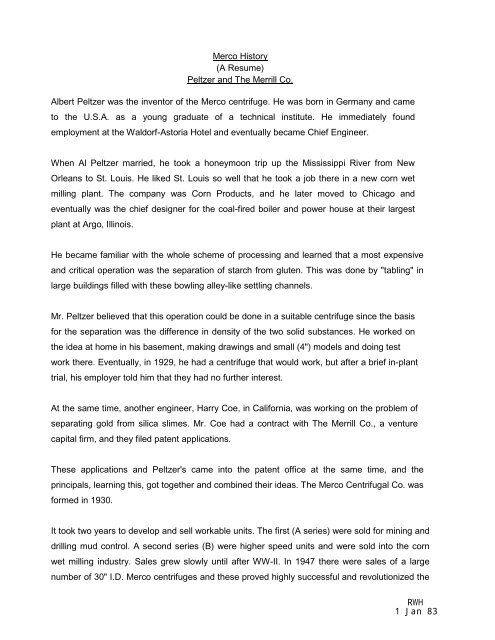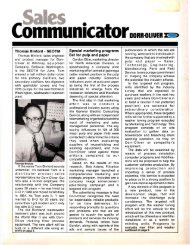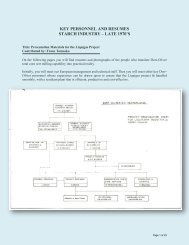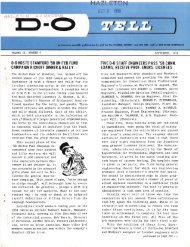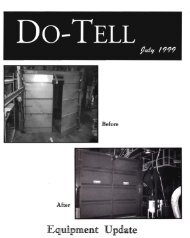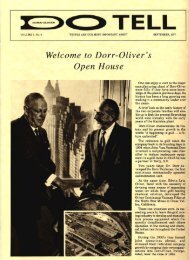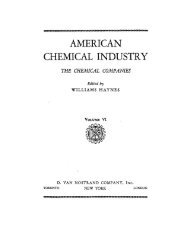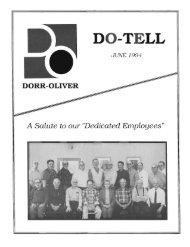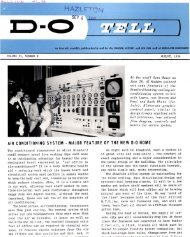Peltzer And The Merrill Co. - Dorr-Oliver Alumni
Peltzer And The Merrill Co. - Dorr-Oliver Alumni
Peltzer And The Merrill Co. - Dorr-Oliver Alumni
Create successful ePaper yourself
Turn your PDF publications into a flip-book with our unique Google optimized e-Paper software.
Merco History<br />
(A Resume)<br />
<strong>Peltzer</strong> and <strong>The</strong> <strong>Merrill</strong> <strong>Co</strong>.<br />
Albert <strong>Peltzer</strong> was the inventor of the Merco centrifuge. He was born in Germany and came<br />
to the U.S.A. as a young graduate of a technical institute. He immediately found<br />
employment at the Waldorf-Astoria Hotel and eventually became Chief Engineer.<br />
When Al <strong>Peltzer</strong> married, he took a honeymoon trip up the Mississippi River from New<br />
Orleans to St. Louis. He liked St. Louis so well that he took a job there in a new corn wet<br />
milling plant. <strong>The</strong> company was <strong>Co</strong>rn Products, and he later moved to Chicago and<br />
eventually was the chief designer for the coal-fired boiler and power house at their largest<br />
plant at Argo, Illinois.<br />
He became familiar with the whole scheme of processing and learned that a most expensive<br />
and critical operation was the separation of starch from gluten. This was done by "tabling" in<br />
large buildings filled with these bowling alley-like settling channels.<br />
Mr. <strong>Peltzer</strong> believed that this operation could be done in a suitable centrifuge since the basis<br />
for the separation was the difference in density of the two solid substances. He worked on<br />
the idea at home in his basement, making drawings and small (4") models and doing test<br />
work there. Eventually, in 1929, he had a centrifuge that would work, but after a brief in-plant<br />
trial, his employer told him that they had no further interest.<br />
At the same time, another engineer, Harry <strong>Co</strong>e, in California, was working on the problem of<br />
separating gold from silica slimes. Mr. <strong>Co</strong>e had a contract with <strong>The</strong> <strong>Merrill</strong> <strong>Co</strong>., a venture<br />
capital firm, and they filed patent applications.<br />
<strong>The</strong>se applications and <strong>Peltzer</strong>'s came into the patent office at the same time, and the<br />
principals, learning this, got together and combined their ideas. <strong>The</strong> Merco Centrifugal <strong>Co</strong>. was<br />
formed in 1930.<br />
It took two years to develop and sell workable units. <strong>The</strong> first (A series) were sold for mining and<br />
drilling mud control. A second series (B) were higher speed units and were sold into the corn<br />
wet milling industry. Sales grew slowly until after WW-II. In 1947 there were sales of a large<br />
number of 30" I.D. Merco centrifuges and these proved highly successful and revolutionized the<br />
RWH<br />
1 Jan 83
industry. Merco grew rapidly.<br />
<strong>Dorr</strong>-<strong>Oliver</strong> Acquisition<br />
In 1957, <strong>The</strong> <strong>Merrill</strong> <strong>Co</strong>. sold this entity to <strong>Dorr</strong>-<strong>Oliver</strong>, which was a larger equipment company<br />
selling to a broader market. This encouraged further expansion.<br />
<strong>The</strong> factory was moved to Hazleton, Pennsylvania, and the staff into the D-0 headquarters in<br />
Stamford, <strong>Co</strong>nnecticut, and into regional sales offices.<br />
Product Development<br />
During the 1930's, Merco centrifuges were of the 16" I.D. size. This was considered large at that<br />
time. All the units were made for handling large quantities of solids in round-the-clock production<br />
plants. <strong>The</strong> centrifuges were designed to serve continuously for many years. This is still the<br />
case.<br />
After WW-II, most of the units sold were 30" I.D. size and nearly every unit sold since then is<br />
still in full-time service. Some have revolved more than 25 billion times. (This compares with<br />
the earth which has revolved around the sun about 4.5 billion times so far.)<br />
After D-O acquired Merco, there was a spurt in new development work and new types and<br />
sizes of Mercos were introduced so as to serve a wider market. This included versions for<br />
high pressure (156 psi) and temperature (450°F), for liquid-liquid separations, for more<br />
corrosive service, higher speeds, improved sanitation, and, most recently, our largest model,<br />
which is now the Merco H-36.<br />
<strong>The</strong> Merco H-36 is the largest disc-nozzle centrifuge in the world, and we have sold over<br />
eighty of these thus far. We have had units in full-time service since 1974, and they have<br />
proven very successful and most economic. In fact, their low Hp usage is a prime factor in<br />
their selection.<br />
In addition, we also now have a line of screen solid bowl centrifuges - the Mercones –<br />
and a line of solid-bowl centrifuges the MercoBowls.<br />
<strong>The</strong> broadening of our product line enables us to serve more markets and we thus learn<br />
more about how to design and build equipment to satisfy diverse requirements. This, we<br />
feel, means progress.<br />
RWH<br />
1 Jan 83
Applications Development<br />
We are learning something new every day. <strong>The</strong> wider our horizons have become, the<br />
more we have been able to incorporate special design features and thereby perfect the<br />
product. Changing technology and materials and methods makes this an everexpanding<br />
frontier.<br />
From our beginnings in food processing, we have worked with stainless steel and corrosionresistant<br />
materials. As we developed applications in the chemical field, we had more severe<br />
environments (sulfuric acid, phosphoric acid, mixed products salt solutions, caustic, tars,<br />
solvents, products, waxes, explosives, etc.)<br />
We also adapted out Merco centrifuges to effect counterflow washing, thickening, and<br />
clarification, in addition to solids size classification and heavy media type separations. <strong>The</strong>re are<br />
instances of high and low viscosity, high and low solids percentages, stickiness, polymerization,<br />
heat sensitivity, etc.<br />
When we entered the field of municipal waste treatment, we encountered a whole new<br />
environment of trash and carelessness, irresponsibility, and urgency and liability. We had to<br />
effect many changes in our approach and in our scope of supply. In particular, we learned about<br />
abrasive wear and how it has to be combated by both prevention and repair.<br />
We have about one hundred units operating today under abrasive conditions we had not worked<br />
against until ten years ago. We have had to design special screening and degritting systems,<br />
internal and external hard facing, nozzle sleeves, special nozzle shapes, housing changes, etc.<br />
we have also instituted certain installation and inspection practices and procedures. Finally, we<br />
have set up an exchange pool of units and standardized charges so that repairs are done<br />
economically and on a scheduled basis.<br />
We believe that this history of invention and development places <strong>Dorr</strong>-<strong>Oliver</strong> and Dorcan in a<br />
particularly well-suited position to serve the tar sands industry. We have the equipment and the<br />
organization to be of significant service.


